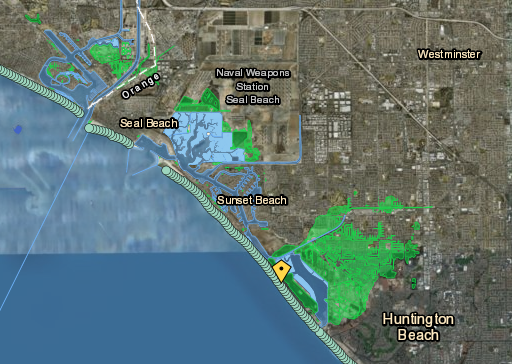One of the many global phenomena climatologists deem inevitable is the rising sea level. And, in 2019, this could prove devastating to Southern California’s coastline. Due to its Mediterranean climate, the SoCal coast is prone to arid summers and damp winters. This winter, we are to expect quite literally a perfect storm of sea level rise and wetter-than-usual weather with the likely arrival of an El Nino. This will have consequences for California’s communities and habitats, ranging from immediate (flooding) to more gradual (cliff retreat). For a sobering, realistic view of how the sea level is rising and its impact on coastal cities worldwide, NOAA has created a tool, the “Sea Level Rise Viewer,” for the public.
 |
| Flood Map from the Our Coast, Our Future web viewer (used with permission by Point Blue Conservation Science and USGS). * Green indicates ¨low-lying flood prone¨ areas. |
Flooding
As the eastern Pacific warms, the forthcoming El Nino phase portends flooding on the American West Coast. According to the interactive flood map of the web project, Our Coast, Our Future, the “flood-prone low-lying areas” of Southern California include (south to north): Oceanside, Huntington Beach, parts of the Los Angeles’ coast (along the San Gabriel River and Port of Long Beach), Playa Vista, areas in Malibu, along the Revelon Slough in Oxnard, along the Santa Clara River, Montecito, as well as areas around UC Santa Barbara. Tidal wetlands, such as the Bolsa Chica Ecological Reserve (featured in flood map image), are particularly vulnerable to flooding during seasons with high precipitation.
Shrinking Coastline
A rising sea level also erodes cliffs and bluffs. The U.S. Geological Survey (USGS) recently conducted a study of Southern California’s deteriorating cliffs, applying their model to almost 300 miles of coastline. More specifically, a large part of the Santa Barbara coastline was surveyed, with smaller sample sizes of Ventura and Los Angeles, as well as San Diego. They found that, by the century’s end, anywhere from “19 to 41 m[eters]”1 of the coast will have retreated (Limber et al.). The study anticipates that the cliffs of San Diego will experience the most rapid retreat, due to their lithology, with those of Orange County at the slowest, due to their relatively protective topography. Evidently, the casualties in these cities include the habitats of endangered wildlife, whole residences, businesses, and public property. As the L.A. Times reports, “In Malibu and other coastal cities, blocks of homes, parks and public facilities could be lost to the sea under such projections.”2
How can you help?
The only way we can prevent sea level rise is to cut down on carbon emissions, which involves electing the right officials to office. Donate to the California Sierra Club Political Action Committee to help ensure this. Of course, in addition to flooding and cliff erosion, expanding industrialization also puts us and wildlife in danger. To learn more about protecting the flora and fauna of our wetlands, visit the site for the Angeles Chapter’s Coastal Preservation Campaigns.